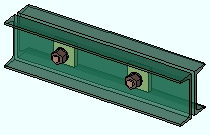Plain End
On this page :
Also see :
- Status Display ( Connection type > Plain end )
user defined | auto standard | beam | column | system
|

|
The left beam has ' Plain end ' as its right-end " Input connection type ."A full-featured SDS2 program sets back the beam and copes it to prevent material interference with the right beam. The program uses the " Plain end " field clearance set on the Field Clearances window at Home > Project Settings > Job . |

|
Here's a double channel vertical brace with stitch plates. Both ends are set to ' Plain End '. The member is displayed in solid transparent main so that you can see the bolted rectangular stitch plates. |
user defined | auto standard | beam | column | system | top
A ' Plain end ' may be applied as a beam-to-beam, beam-to-column, column-to-beam or column-to-column auto standard connection. This might be done for framing situations that call for a connection that cannot be generated automatically.
A ' Plain end ' may be applied on the end of a supported beam or column or brace or as a user defined connection.
A ' Plain end ' may be applied by a full-featured SDS2 program -- in place of the original " Input connection " -- as a result of failure of the connection.
For ' User defined ' connections, 3D solids are created for the connection even when it fails -- the connection is not set to ' Plain end '.
user defined | auto standard | beam | column | system | top